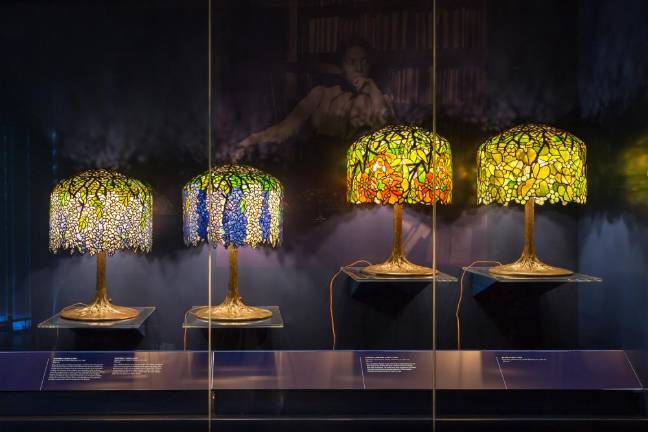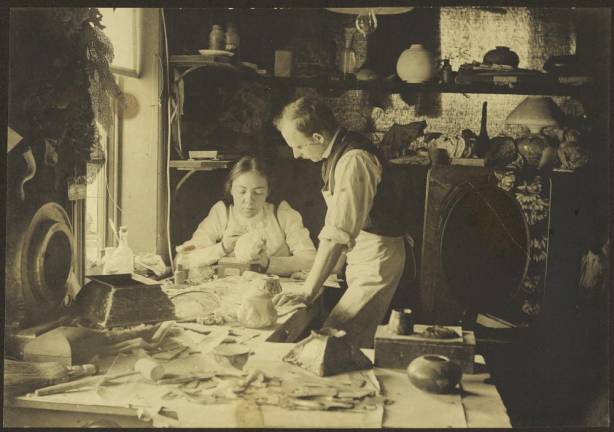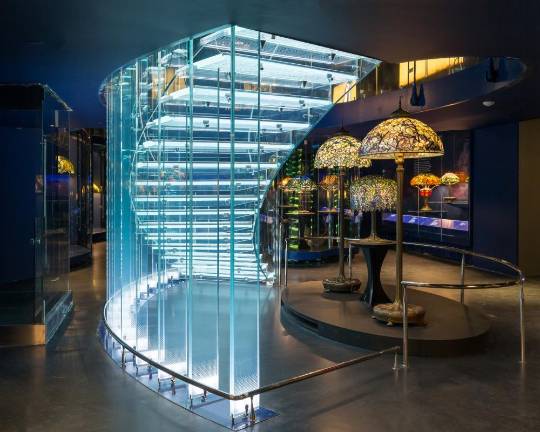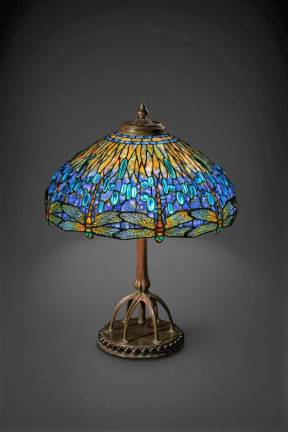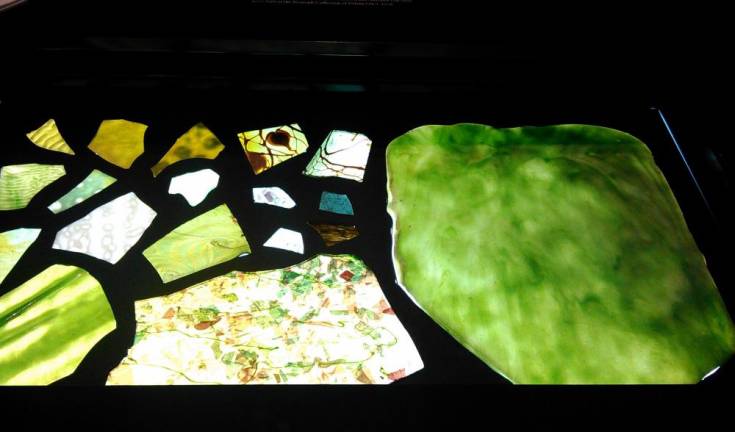Anyone looking for an oasis of calm during the frenzied holiday season will find a refuge of beauty, craftsmanship and serenity – and get a history lesson to boot – at the New-York Historical Society.
The Society’s permanent Tiffany lamp exhibit is a stroll through a colorful garden without getting your shoes dirty. On the two levels of this fourth floor exhibit, you’ll find more than 100 exquisite lamps, softly lit to reveal magnolias, poinsettias, cyclamen, apple blossoms, daffodils, restrained bamboos and lively dogwoods, grapes, roses, black eyed susans, peonies, poppies, tulips, nasturtium, lily pads, wisteria and of course, the famed dragonfly lamps. The designs range from simple geometric patterns to intricate wisteria lamps with as many as a thousand pieces of glass and pressed glass "jewels.” They perch atop graceful, art nouveau -inspired bases and floor lamps, and hang suspended from stanchions.
And almost all of them sprang from the imagination of a single artist – Clara Driscoll. In a coincidence straight out of a 19th century novel, her story – and the story of the “Tiffany girls” – was untold until a relatively recent discovery
The Main Creative Force
“Driscoll came to NYC from Ohio to finish her art training in 1888 and started at Tiffany later that year,” explained Margaret K. Hofer, vice president and museum director of the Historical Society. Driscoll, who led the women’s glass cutting department, was the main creative force for Tiffany’s nature-inspired lamps for years. But her role wasn’t revealed until 2005, when two different researchers literally hit the mother lode with two little-known caches of Driscoll’s letters one in Queens and one in Ohio. “These were thought to be just family history,” Hofer said, “but in a closer read there were details about her creative process and inspiration ... and sentences like 'Today I had an idea for a dragonfly lamp.'" To a Tiffany enthusiast, that’s the equivalent of an art historian finding a letter from Renoir saying “I’m starting to experiment with pastels.” (Selections from Driscoll’s letters, narrated by Lois Chiles, are available on touch screens scattered throughout the lower level).
The discovery of the letters, along with a hugely popular show about Driscoll that the Society staged in 2017, led to a redesign of the fourth floor and the installation of the permanent Tiffany lamp exhibit.
An Extraordinary Collection
Now, the Gallery of Tiffany Lamps is a soaring, 4,800-square-foot, two-story space, anchored on the lower level by 100 illuminated Tiffany lamps from the Society’s collection, which is among the world’s largest. On the upper level, photographs and other archival material, including tools and samples of Tiffany glass, explain how the lamps were designed and made. Together, the two floors offer a complete view of the artistry of Driscoll and the Tiffany Girls. (Men also designed lamps, albeit all strictly geometric designs.)
Each lamp is breathtaking in its own way, but standouts are the examples of the famed Dragonfly shade, including design variants with brass filigree and gleaming glass “jewel” eyes. A pair of Wisteria lamps shows how different shades and colors of glass look on the same basic metal template; these lamps required hundreds of pieces of glass and have sold at auction for six figures or more. The entire collection was donated by one man, Dr. Egon Neustadt, and began with his purchase in the 1930s of a daffodil lamp from an antique store...for $12.50.
A large part of the art of the Tiffany Girls lay in their selection of the glass used in each lamp for subtle color and effects, said Hofer. “Tiffany thought women were more sensitive to colors,” she explained. Each piece of glass was chosen deliberately, to leverage the subtleties of the colors into the design. “See how the mottled qualities of the glass used for the blossoms make the lamp resemble flowers seen through sunlight,” Hofer said, pointing to a standing magnolia lamp.
A Dizzying Array of Subtle Color
Walking through the lower floor is food for the soul. Each of the dozens of lamps in standing displays or along the walls glows in a dizzying array of subtle color. The red in the poppy and rose shades “pop.” The exuberant wisteria drapes gracefully in a spectacle of blues or yellows. Even the relatively sedate bamboo lamps dazzle; the graceful stalks splay across the torchiere shade and astonish with the subtle shades of green displayed in subtle striations along the stalks.
Throughout the exhibit, you are always reminded that the lamps were a business. The metal templates of floral designs were used repeatedly; a case holds two lamps with the same “Wisteria” template, but differences in colors and tones made each look unique. With some exceptions, patrons could choose from a variety of lamp bases for their shades, from sinuous art nouveau to sedate pillars or exotic orientalist fantasies.
Driscoll noted the business considerations in a letter home, available on the touch screens by the dragonfly display case. She confesses her worries that her innovative dragonfly lamp motif was too expensive to make to be profitable, since Tiffany would have to charge an astounding $250. (Luckily, Mr. Tiffany said yes).
Tools of the Trade
While the lower level is given over to the art and craft in the lamps, the upper level explores the manufacturing process. One of Driscoll’s sketched and colored patterns on canvas for a Daffodil lamp is displayed, along with examples of the metal templates for a lamp and a wooden lamp mold on which the template was placed. There are also glass cutters, pliers, some of the delicate filigree used for dragonfly wings and the copper wiring used to edge each piece of glass before fitting it to the lampshade mold.
And in case you think it was easy to sort through an infinite variety of colors and textures to create a lamp, you can try it yourself. A hands-on “Design-a-Lamp” experience lets you select “glass” for a Dragonfly shade in different colors and see the results on a three-dimensional illuminated model. A few minutes of this will give you a huge appreciation for the talents of Clara Driscoll and the Tiffany girls, who finally, at long last, got their due.
IF YOU GO
What: Gallery of Tiffany Lamps
Where: New-York Historical Society
170 Central Park West at 76th St
When: Ongoing
